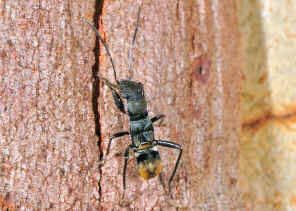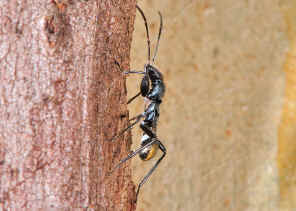Ant-mimicking Seed Bug - Daerlac nigricans
Family Rhyparochromidae
This page contains pictures and information about Ant-mimicking Seed Bugs that we found in the Brisbane area, Queensland, Australia.

- Body length 10mm
- Yes, this is a true bug but not an ant. Its body colour and behaviour is mimicking a black ant. The head is large and triangular with ocelli. Antennae are four segmented and fore femora are swollen and armed with spines. Abdomen is golden brown in colour.



- It was found wandering on a large gum tree trunk, where a lot of black ants is running around.

- Adults run fast on gum tree trunk. They usually found alone there. Just hard to understand why they were them. Also they have very strong front legs, may be they were predator.....
- Why mimicking ant? Ants
are the most abundant group of insects and have powerful defence mechanisms
such as acid taste, aggressive biting, painful sting, and group defence. Ants
are generally not subject to predation. They are the ideal models in mimicry
rings. Many insects and spiders have different ways to resemble ants. This is
known as Myrmecomorphy.
Myrmecomorphy highlights an important aspect of mimicry - the behaviour. Predators use different aspects of prey appearance when making a decision to attack. Behaviour is an important part of multi-modal signals. Constant waving of antennae is a common feature of ants. Ants are also characterized by their jerky and zigzag movements. Those ants behaviour are commonly seen in the ant mimics
Ant-mimicking
Nymph



- Notice that the seed bug does not have the waist, which is the characteristic of all ants, but its body colour pattern mimics just exactly this. From our reference books, ant-mimic bug could be lygaeids, alydids or mirids. From its head and antenna it looks like a lygaeids. Then we found out they are in Rhyparochromidae family.



- Reference:
- 1. Terrestrial Invertebrate Status Review (Brisbane City) - Dr John Stanisic, Queensland Museum, 2005, page 61,63.
- 2. Insects
of Australia, CSIRO, Division of Entomology, Melbourne University
Press, 2nd Edition 1991, pp 501.
- 3. Family RHYPAROCHROMIDAE - Australian Faunal Directory, Australian Biological Resources Study.
- 3. Family RHYPAROCHROMIDAE - Australian Faunal Directory, Australian Biological Resources Study.
